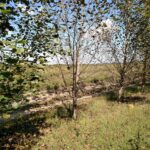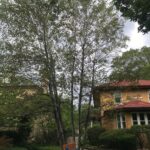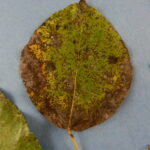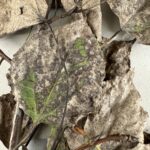Aspen, cottonwood, and poplar are all names for the fast-growing Populus tree species. Used widely for building materials, these trees are often located around ponds, riverbanks, and sloping areas toward water bodies (especially cottonwood). Cottonwood flowers produce little white tufted seeds that float through the air which a lot of people love (my kids included), unless it lands in their mouth. These beautiful trees are susceptible to a fungus that can cause significant damage under the right conditions: Marssonina (newer name is Drepanopeziza).
There are three species of Marssonina that can infect Populus – different tree species may only be susceptible to one of the Marssonina species. The fungi cause the same kind of disease and develop similarly on the host. Marssonina can infect the leaves, stems and seeds of Populus, which can lead to large amounts of leaf loss during wet weather, girdled stems and dieback, and aborted seeds. Since seeds can carry the fungus, the seed will take it with it to where it lands and can become infected immediately after germinating. It is common to see high disease severity in the canopy, but unless there is significant leaf loss (up to 70% defoliation) it may not reduce plant vigor. Leaf lesions typically develop as small black to brown dots or flecks which expand in size as time goes one. As the disease progresses, large areas of the leaf will become necrotic, creating odd dead blotches, potentially killing the majority of the leaf blade.
The fungus produces asexual spores in a small black pustule on the upper surface of the leaf which will eventually burst and release the spores during humid weather early in the spring. Marssonina will continue to produce spores and cause disease the whole season, creating repeat infections on the same tree. Symptoms tend to start lower in the canopy and ascend up the tree as the season progresses. The spores are spread by water splash, so rainfall will help spread this fungus in the landscape.
For trees planted in native landscapes, this disease will likely be inevitable and may make the foliage look less than stellar. That being said, removing leaves that drop or at the end of fall will reduce total inoculum for future seasons and can reduce total disease long-term. Similarly, trees that are stressed will typically develop increased disease severity, so if you are seeing large amounts of leaf spots or leaf loss, I would recommend employing stress mitigation strategies to keep the tree happy and healthy (fertilizer, mulch, irrigation as needed, etc.). If a tree appears to develop significant disease every year and has reduced limb growth, you may consider removing the tree if you are concerned it may die early and replace with a resistant clone, as disease susceptibility can vary greatly between clones of the same species.
- Fig 1: Populus sp. with significant leaf loss due to Marssonina leaf spot. Photo credit: PPDL
- Fig 2: Aspen wit thinning tree canopy due to Marssonina infection.
- Fig 3: Necrotic flecks and dots associated with early infection by Marssonina. Photo credit: PPDL
- Fig 4: Leaf necrosis and twig dieback caused by Marssonina.
- Fig 5: Severely leaf necrosis of an aspen tree caused by repeat infections by Marssonina. Photo credit: PPDL




